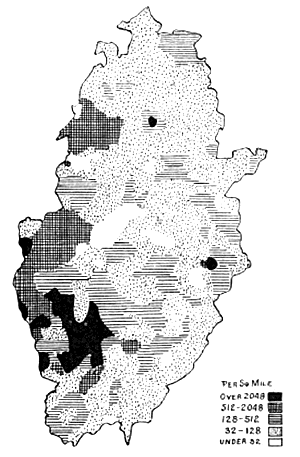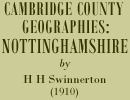< Previous | Contents | Next >
11. People—Origin, Race, Population.
In the chapter on Natural History it was seen that the animals and plants of Britain came originally from the Continent. The same is true of its people.
How long man has existed on the earth no one can say. No even approximate guess can be hazarded, and it is not likely that our lack of knowledge in this respect will ever be enlightened. But from recent researches in Crete it seems reasonable to suppose that a high state of civilisation was in existence there, and no doubt in other parts of the Mediterranean basin, perhaps as much as, or even more than, 10,000 years ago. This civilisation never reached our shores, but in times far more remote than these man was existent in Britain. Almost all traces of him, save of the implements he made—chipped flints for hunting and warfare—have vanished, but we know that he was a contemporary of the mammoth, woolly rhinoceros, and cave bear when these animals inhabited our land, that he was a hunter pure and simple, with no domestic animals and doing little or nothing in the way of agriculture, and that he had not learnt to grind and polish his weapons. He is known as Palaeolithic man—man of the Old Stone Age.
How long a period intervened in Britain between him and his successor, Neolithic man, or man of the New Stone Age, it is impossible to say, but most authorities agree that the gap is very great. When our land became again peopled it was by a race probably Iberian, from south-west Europe, which, though still ignorant of the use of metals, had attained a certain degree of civilisation, possessing the domestic animals, raising crops, and knowing the arts of spinning and weaving. The Neolithic Age no doubt lasted for a very prolonged period.
How long this Iberian race had been settled in our land before the advent of the Celtic races we do not know. These latter came in two separate invasions and introduced the Age of Bronze. The Goidels or Gaels overran the country, driving their predecessors into the hills and fastnesses of Wales. Later the Brythons or Britons came, pushing the Gaels before them to the north; and at the beginning of our era the Romans appeared, bringing with them their legionaries drawn from the various countries of their conquest.
The Teutonic invaders of our island entered by the rivers which open on to the east coast. The Jutes and Saxons settled in the east and south of England; the Angles and Danes in the midlands and the north.
The Angles seem to have travelled westwards from Lincolnshire along the old Roman Fosseway. From this they wandered into our county and dotted those parts not covered by marsh with farmsteads. The Sites of their settlements are still indicated by the suffixes ton and ham in so many village names, as Ruddington, Hoveringham. The forest did not daunt them. They felled the trees and made clearings, the memory of which is still preserved in such names as Mansfield and Farnsfield.
After the Angles had become established the Danes came. Some of them entered Yorkshire by the Humber and thence worked southwards to Nottinghamshire. The grouping of such names as Serlby, Ranby, Scrooby in the north-west of the county is an indication of their complete settlement there. Gunthorpe, Knapthorpe and other like names may have a similar significance.
Last of all came the Normans. They also were Teutonic, but belonged to a branch of the race which had settled first in the North of France.
The population of Nottinghamshire is therefore mainly Teutonic, and might perhaps be roughly described as Anglo-Danish.
The Teutonic tribes which invaded Britain spoke different dialects. That spoken by those who settled in the Midlands became in course of time the English language. Hence it is that in this county the native dialect does not differ from English as much as does the dialect of the men of Yorkshire or Wiltshire.
The mixed nature of our ancestry has been well summarised by Professor A. H. Keane. “Britain,” he says, “has been successively occupied by a great number of peoples—primitive man in the Old Stone Age; Picts, and perhaps others associated with the dolmens and other megalithic monuments, in the New Stone Age; tribes of Keltic speech, commonly called Kelts, in the Bronze Period, possibly as early as 2000 B.c.; Belgae or protoTeutons somewhat later; Romans and their legionaries of diverse origins about the New Era; early and later Frisians, Saxons, Angles and others of Teutonic speech, say between 300 and 500 A.D.; Scandinavians, chiefly Danes and Norwegians, of kindred speech, eighth to tenth century; Normans, mainly Norsemen Romanised in speech, eleventh century; with sporadic arrivals from the mainland down to the present time.”
There is no record from which we may gather the exact number of people in Nottinghamshire in early times. The first census was taken in 1801, when the population of the county was 140,350. By 1901 it had increased to 514,578 persons. Half of these were born in the county. The others were from every county in England and Wales as well as from other parts of the world. This fact illustrates the rapidity with which the population of the country is becoming mixed.

Map showing the distribution of population in Nottinghamshire in 1901.
The average number of persons per square mile in 1901 was 610. The corresponding number for England and Wales was 558; for the most crowded county—Lancashire—2347; for the least crowded—Westmorland—82; for London, 38,774.
In Nottinghamshire the population was most concentrated on the west, especially along the Leen and Erewash valleys. The most thinly populated parishes were Welbeck, Rufford, and ‘Wiverton Hall, each of which had less than twenty-five people to the square mile.
During the nineteenth century the population increased 397 per cent. in England and Wales and 400 per cent. in Nottinghamshire. In this county the greatest increase took place in the west. This was due to the exploiting of the underlying coalfield and the consequent growth of manufacturing industries. In the east, with the exception of Retford and Newark, the population, which is largely agricultural, was either stationary or had decreased. The decrease was most marked in that extensive piece of country between Rufford, Tuxford, and Newark. In some parishes the decrease amounted to as much as 70 per cent.
If the population of the whole county has continued to increase since 1901 at the same rate as it did from 1891 1901 it will amount in 1911 to 593,823, but there are indications that the number will be greater still.
